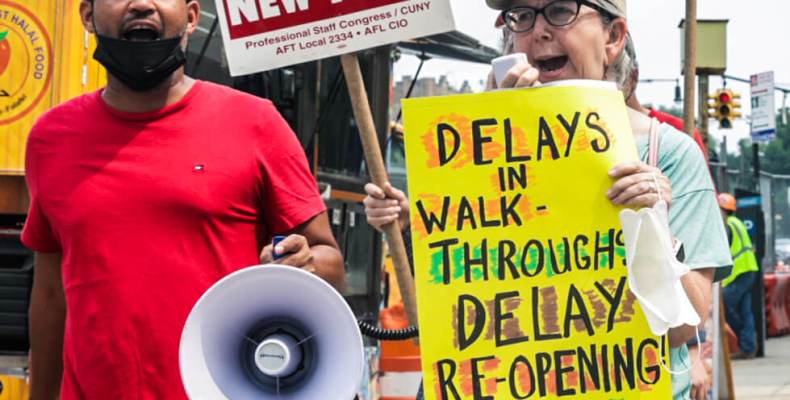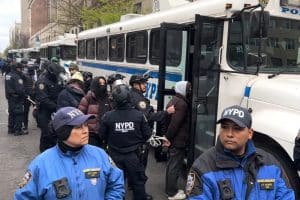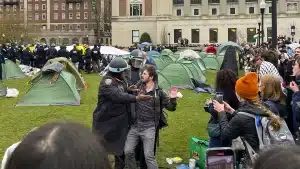On Wednesday, thousands of faculty and staff at the City University of New York (CUNY) and hundreds of thousands of students will be returning to college campuses across the city for the first time since the coronavirus closed the entire system down last year. The university’s plans for reopening, largely developed over the summer when Covid cases in New York City were rapidly declining, have changed little since the delta variant began to circulate. Since then, new infections across the country have increased by more than 1,000 percent, and currently there are more than 2,000 new infections being reported daily in New York City alone, while deaths across the United States are now above 1,000 a day. Because of this, many faculty and staff say they are worried about their safety and that CUNY and the Professional Staff Congress union (PSC-CUNY) — which represents more than 27,000 faculty and staff — are not doing enough to protect them, their students, or the people of the city.
“I’m extremely concerned that CUNY has not thought things through carefully, and that the semester ahead will be rocky and dangerous,” said one adjunct lecturer who wished to remain anonymous.
The fall was supposed to be the comeback semester for CUNY, with a significant portion of classes offered in person, and the chancellor and college presidents seem to be sticking to that plan despite the recent outbreak. While each campus has its own set of guidelines for reopening, almost all are requiring that staff be on campus at least two days a week and are asking that close to half of the courses offered this fall meet on campus at least one day a week. This means that some faculty and staff will be required to be on campus, in crowded classrooms and small cubicles, several days a week. In some buildings at Hunter College, for example, windows are the only available source of ventilation, but administration will not allow them to be opened.
Although some campuses are thankfully requiring students, faculty, and staff to wear masks, social distance, and show proof of vaccination or a negative Covid test within the last seven days, workers say these measures are not enough to protect them. Many faculty and staff, for instance, have argued that proper social distancing will be impossible in small classrooms with 25 to 30 students, and that a week between Covid testing is far too long for a virus that can become transmissible even before a test can detect infection. Worst of all, evidence is piling up that vaccines do not offer the same level of immunity against the delta variant as the original coronavirus, and with breakthrough infections increasingly common, it’s likely that even vaccinated people will be significant sources of outbreaks, especially in crowded classrooms and halls. As one adjunct who teaches at several campuses across the university system said, “I have two friends who have had breakthrough Covid; Covid cases are spiking right now. This shit is not over…I mean how do you go through an entire year where faculty have died, students have died, staff have died or gotten seriously ill, and say ‘well, we’re just going to ignore this and continue on with our plan’? It’s just callous.”
While the university has not done much to change its reopening plans to adjust to the new reality of the delta variant, the protocols for closing CUNY in the case of an outbreak seem to be identical to those the university was using in 2020. Currently, the university is saying that it will close campuses only if there is a “substantial” spread of infections, a decision that will be made not by workers or students, but by the undemocratically appointed CUNY Board of Trustees. While the university has not quantified what “substantial” means, it’s clear that there could be massive outbreaks before campuses even consider closing. This would mean hundreds, if not thousands, of new cases introduced into the community.
This business-as-usual response is especially troubling since we know that the delta variant spreads much more quickly and easily than the original virus, and that it can spread even among vaccinated populations. The rate of infection for the original strain of Covid was relatively low compared to other diseases: infected people on average spread the disease to about three other people before isolation. With the delta variant, that number has more than doubled, and every sick person with delta now infects on average seven other people. While vaccinations can slow that rate of transmission, breakthroughs are common, and can be especially bad since the vaccinated may no longer take the same precautions as others. In fact, the rate of infection for delta is much closer to the highly contagious chickenpox than it is to the original Covid strain, and this is why we have seen cases increase across the country so rapidly despite mass vaccination efforts. Opening any schools with such high infection rates, even with masks and vaccinations, could be a disaster for the city, prolonging the current wave of infections or leading to new waves down the line.
Clearly this is a bad policy, but some CUNY workers have argued that such callous indifference is actually by design and that the plans for reopening have more to do with protecting the university’s enrollments and coffers than its workers. The university administration knows very well that, unless the delta variant peaks soon, it will likely have to close not long after reopening. So, why is it continuing to go forward? Why have they not postponed the start date in order to avoid such outbreaks? One reason is that many students were still enrolling even as late as this week, and tuition does not become non-refundable until after the first several class meetings. “They want campuses open, they want classes in person because they think that that’s what is going to draw undergraduate students back,” said one staff member, who added, “I would be really shocked if colleges all make it to the end of the semester.” Although it is true that many undergraduate students are hungry to return to in-person learning after two semesters of online classes, they are just as worried as the faculty and staff about returning, and many in-person courses seem to have low enrollments even as online courses are filling up.
Meanwhile, PSC-CUNY leadership has focused almost exclusively on collaborating with the administration in developing the re-opening plan with little input from or discussion with the rank and file. This lack of organization and input mirrors the union’s historically collaborationist relationship with management and the state, as well as its weak response to the ongoing Covid crisis, which has resulted in the deaths of dozens of union members and the loss of thousands of jobs last fall.
To its credit, the union has been adamant about making sure that mask and vaccination mandates are required, has developed health and safety committees on every campus, and has politely asked the university to “recalibrate the reopening” until September 14, the deadline for all students to submit proof of vaccination. But just like CUNY, the union continues to act as if the delta variant were nothing but a minor bump on the road back to normal, and has no plans for challenging the reopening or attempting to force the university to postpone classes, as Chicago public school teachers did in January.
You might be interested in: What Are Unions and Why Do They Matter?
Despite these efforts, many faculty and staff have complained that the union seems not to have an escalation plan for how to address the real problems of reopening and has done little to prepare the ground for the kinds of actions that would be needed to actually protect their members. One City College adjunct captured this sentiment well:
“I’ve appreciated that the PSC has said all the right things thus far, but it’s not clear to me what union strategy looks like moving forward, nor how their rhetoric and advocacy will translate materially in the immediate future. While certain PSC chapters have been active, my sense is that the PSC is in a wait-and-see posture, generally, which doesn’t make me feel particularly hopeful given the fact that school starts next week. I’d like the union to be more aggressive about pressuring the administration to push back in-person learning at least to the beginning of October as a first step. That seems like the minimum demand at this juncture.”
Indeed, the PSC-CUNY, thanks to its irrational obedience to the anti-union Taylor Law, has not taken a single job action in its entire history, even as the state and city have continued to slash CUNY budgets, and the majority of the faculty have been transformed into vastly underpaid part-time labor. They did not go on strike, call a sick out, hold a slow down, or even call for a walkout last Fall when thousands of adjunct faculty were laid off, and now, as their members are being sent back to work in unsafe conditions, they have no strategy for fighting back that involves anything more militant than a letter writing campaign followed by small demonstrations.
While it’s tempting to think that such a lack of action is a product of a conservative academic membership, this is not true. Most CUNY faculty are living paycheck to paycheck and rank-and-file union members at CUNY have been agitating for more militant actions for years. Many members that we spoke to expressed a strong desire for more radical actions, including sickouts and strikes, to postpone reopening. The problem is not the membership; it’s the bureaucratic leadership which continues to pour the majority of its resources into supporting and lobbying Democratic Party politicians in Albany, while doing little to engage and organize its own members to act in unison when needed. While it is still unclear how many new infections and possible deaths will result from this reopening, one thing is clear: working people and students need collective organizations that are independent of the Democratic Party and the union and NGO bureaucracies that have betrayed them for decades.











